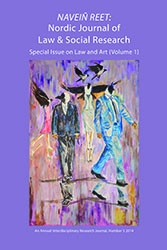Women Lawyers on TV – the British Experience
DOI:
https://doi.org/10.7146/nnjlsr.v0i5.111083Abstract
This paper examines the portrayal on British television of women as protagonists in TV dramas and how this has altered in the past half century. It focuses particularly on two series which follow the fortunes of two Junior barristers and their career paths, each over two separate series. Harriet Peterson and Martha Costello are both women lawyers who appear on behalf of clients in the courts. The barrister branch of the legal profession in England and Wales has always been regarded as the more prestigious branch of the profession from which, traditionally, judges have been selected. The characters are experienced and successful. They have reached that crucial time when they are hoping to be selected as Queen’s Counsel. This step into the top echelon of the elite branch of the split British legal profession is a major marker in a lawyer’s career. It is from the ranks of Q.C.s that the senior judiciary are chosen and where possible fame lies. This paper looks at their contrasting experiences - the context of women lawyers , the style and nature of the work they are shown as undertaking, the characterisation of the legal profession and in particular the principal protagonists. It also provides the crucial context in which these series were produced. It takes note of the ways in which their male counterparts are portrayed in comparable series The major thing which separates the struggles of Peterson and Costello is the passage of time of some 40 years. The paper explores what changes are found in the way the first and second women lawyer major protagonist appear and the context for these changes. In amongst an extensive roster of drama series centred on lawyers, it should be noted that the series Justice with Harriet Peterson ran between 1971 and 1974 and that of Silk with Martha Costello between 2011 and 2014.1 This is a long gap which requires to be looked at in some depth.
References
Bainbridge, Jason (2009). “‘Sexy Men in Wigs’: North Square and the Representation of
Law on British Television”, Journal of British Cinema and Television (Edinburgh University Press) 6 (1): 83–102.
Cecil, Henry (1958) Brief to Counsel (Allen Lane, London).
Greenfield, S Osborn, G and Robson P (2010) Film and the Law: the cinema of justice (Oxford, Hart).
Masson A and O’Connor K (eds) (2007) Representations of Justice (New York and London: PIE Peter Leng).
Pizzey, Erin (1974) Scream Quietly or the Neighbours Will Hear (Penguin, Harmondsworth).
Robson, Peter (2007 a) Lawyers and the Legal System on TV: the British Experience 2(4) International Journal of Law in Context 333.
Robson, Peter (2007 b) Developments in law and popular culture: the case of the TV lawyer (in Masson, A and O’Connor K (eds.) Representations of Justice (New York and London: PIE Peter Leng).
Robson, Peter (2014) The Law Through The Eye of Courtroom Comedy: The Light
Legal Procedural in Context in Law and Popular Culture: International Perspectives (Eds Michael Asimow, Kathryn Brown, David Ray Papke).
Tims, Hilton (1998) Once a Wicked Lady: a biography of Margaret Lockwood (London, Virgin Books).
Downloads
Published
How to Cite
Issue
Section
License
Counting from number 12 (2022), articles published in NNJLSR are licensed under Attribution 4.0 International (CC BY 4.0). Readers are allowed to copy and redistribute the articles in any medium or format, to adapt and revise the articles, and use the articles for commercial purposes, provided that the readers give appropriate credits.
No Creative Commons licenses are applied on articles in number 1 (2009)-11 (2021). All rights reserved by the authors. Readers are allowed to download, read, and link to the articles published in volume 1 (2009)-11 (2021), but they may not republish or redistribute these articles without permission of the authors.

